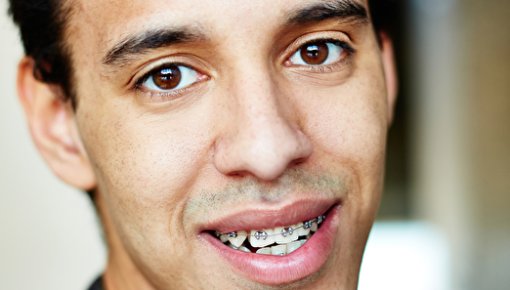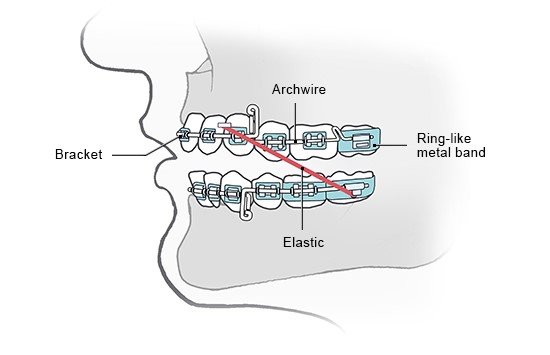Al Makhmari SA, Kaklamanos EG, Athanasiou AE. Short-term and long-term effectiveness of powered toothbrushes in promoting periodontal health during orthodontic treatment: A systematic review and meta-analysis. Am J Orthod Dentofacial Orthop 2017; 152(6): 753-766.
Batista KB, Thiruvenkatachari B, Harrison JE et al. Orthodontic treatment for prominent upper front teeth (Class II malocclusion) in children and adolescents. Cochrane Database Syst Rev 2018; (3): CD003452.
Benson PE, Parkin N, Dyer F et al. Fluorides for preventing early tooth decay (demineralised lesions) during fixed brace treatment. Cochrane Database Syst Rev 2019; (11): CD003809.
Carter LA, Geldenhuys M, Moynihan PJ et al. The impact of orthodontic appliances on eating - young people's views and experiences. J Orthod 2015; 42(2): 114-122.
Deutsche Gesellschaft für Kieferorthopädie (DGKFO). Wissenschaftliche Stellungnahme zur Verankerung mit Gaumenimplantaten und Kortikalisschrauben in der Kieferorthopädie. 2017.
Fleming PS, Strydom H, Katsaros C et al. Non-pharmacological interventions for alleviating pain during orthodontic treatment. Cochrane Database Syst Rev 2016; (12): CD010263.
Frank W, Pfaller K, Konta B. Mundgesundheit nach kieferorthopädischer Behandlung mit festsitzenden Apparaten (Schriftenreihe HTA in der Bundesrepublik Deutschland). 2008.
Ishaq RA, AlHammadi MS, Fayed MM et al. Fixed functional appliances with multibracket appliances have no skeletal effect on the mandible: A systematic review and meta-analysis. Am J Orthod Dentofacial Orthop 2016; 149(5): 612-624.
Jambi S, Thiruvenkatachari B, O'Brien KD et al. Orthodontic treatment for distalising upper first molars in children and adolescents. Cochrane Database Syst Rev 2013; (10): CD008375.
Lentini-Oliveira DA, Carvalho FR, Rodrigues CG et al. Orthodontic and orthopaedic treatment for anterior open bite in children. Cochrane Database Syst Rev 2014; (9): CD005515.
Littlewood SJ, Millett DT, Doubleday B et al. Retention procedures for stabilising tooth position after treatment with orthodontic braces. Cochrane Database Syst Rev 2016; (1): CD002283.
Mandall NA, Hickman J, Macfarlane TV et al. Adhesives for fixed orthodontic brackets. Cochrane Database Syst Rev 2018; (4): CD002282.
Millett DT, Cunningham SJ, O'Brien KD et al. Orthodontic treatment for deep bite and retroclined upper front teeth in children. Cochrane Database Syst Rev 2018; (2): CD005972.
Pschyrembel online. 2022.
Sander FG, Schwenzer N, Ehrenfeld M. Zahn-Mund-Kiefer-Heilkunde: Kieferorthopädie. Stuttgart: Thieme; 2011.
Turner S, Harrison JE, Sharif FN et al. Orthodontic treatment for crowded teeth in children. Cochrane Database Syst Rev 2021; (12): CD003453.
Ugolini A, Agostino P, Silvestrini-Biavati A et al. Orthodontic treatment for posterior crossbites. Cochrane Database Syst Rev 2021; (12): CD000979.
Wang Y, Liu C, Jian F et al. Initial arch wires used in orthodontic treatment with fixed appliances. Cochrane Database Syst Rev 2018; (7): CD007859.
IQWiG health information is written with the aim of helping people understand the advantages and disadvantages of the main treatment options and health care services.
Because IQWiG is a German institute, some of the information provided here is specific to the German health care system. The suitability of any of the described options in an individual case can be determined by talking to a doctor. informedhealth.org can provide support for talks with doctors and other medical professionals, but cannot replace them. We do not offer individual consultations.
Our information is based on the results of good-quality studies. It is written by a team of health care professionals, scientists and editors, and reviewed by external experts. You can find a detailed description of how our health information is produced and updated in our methods.


